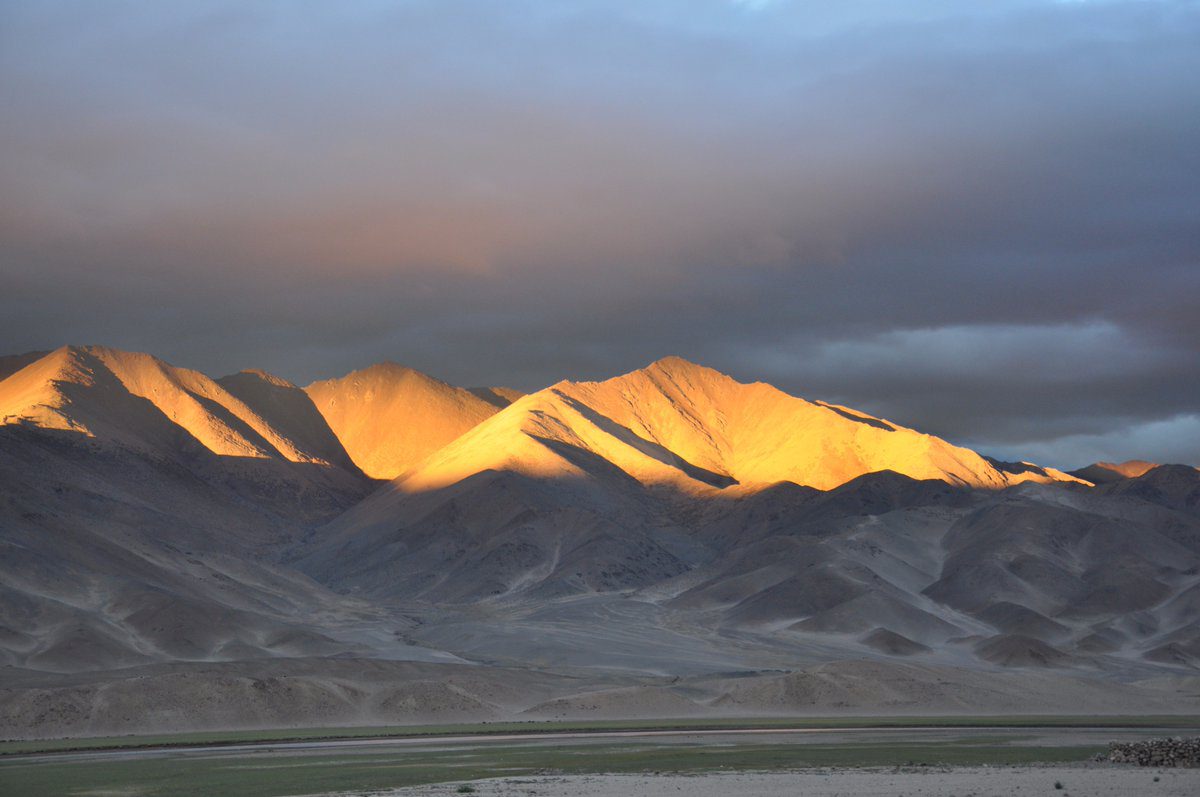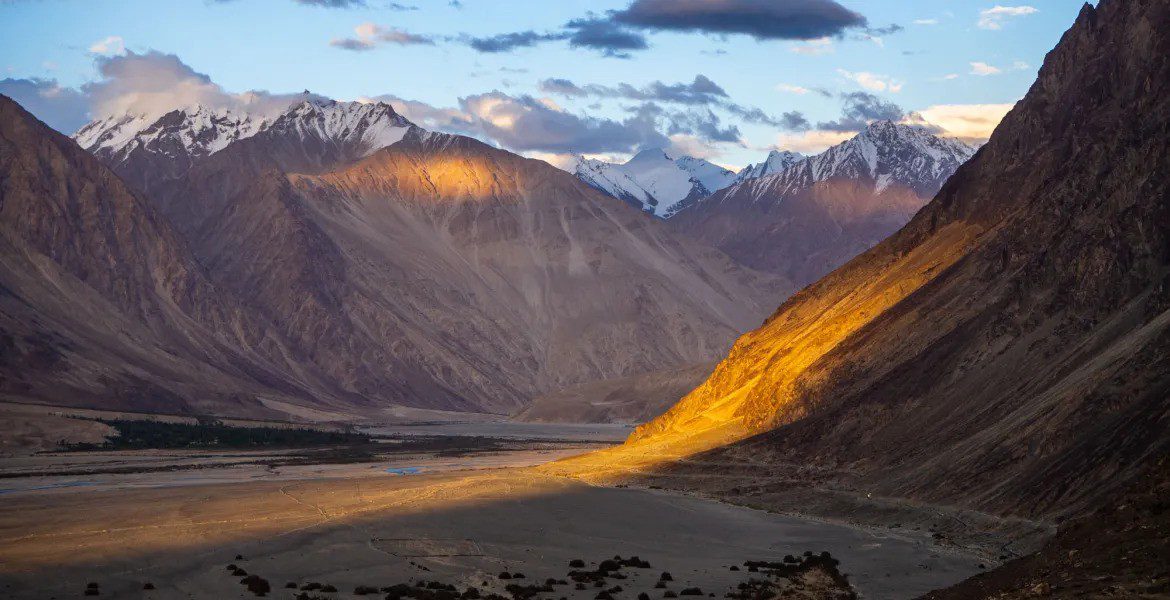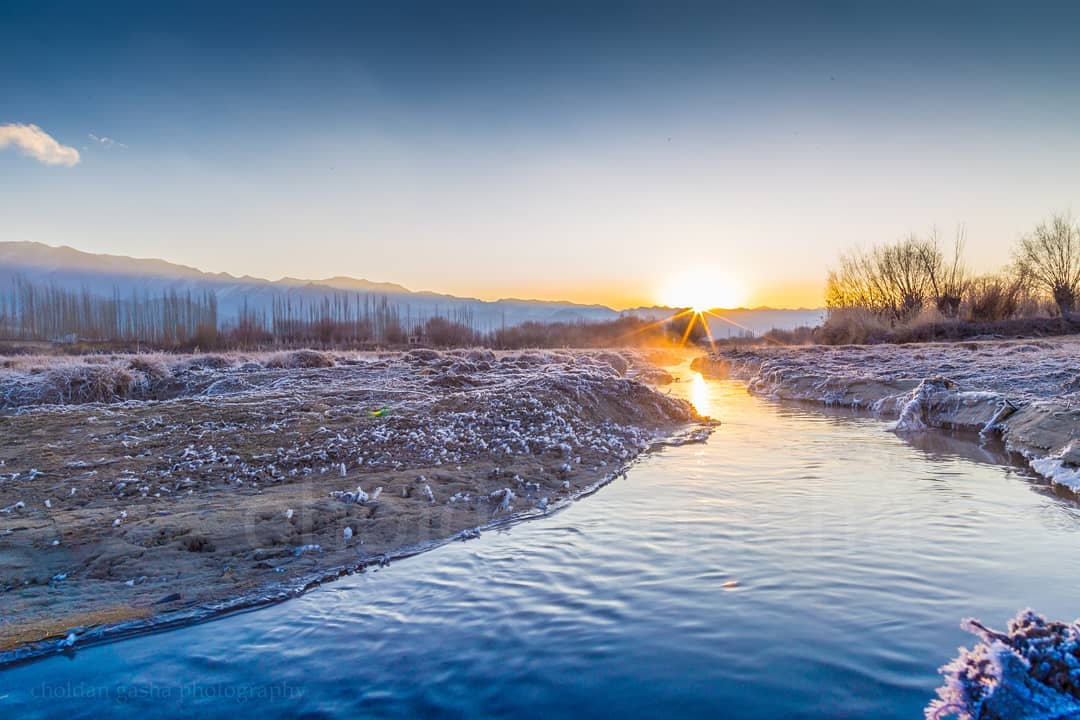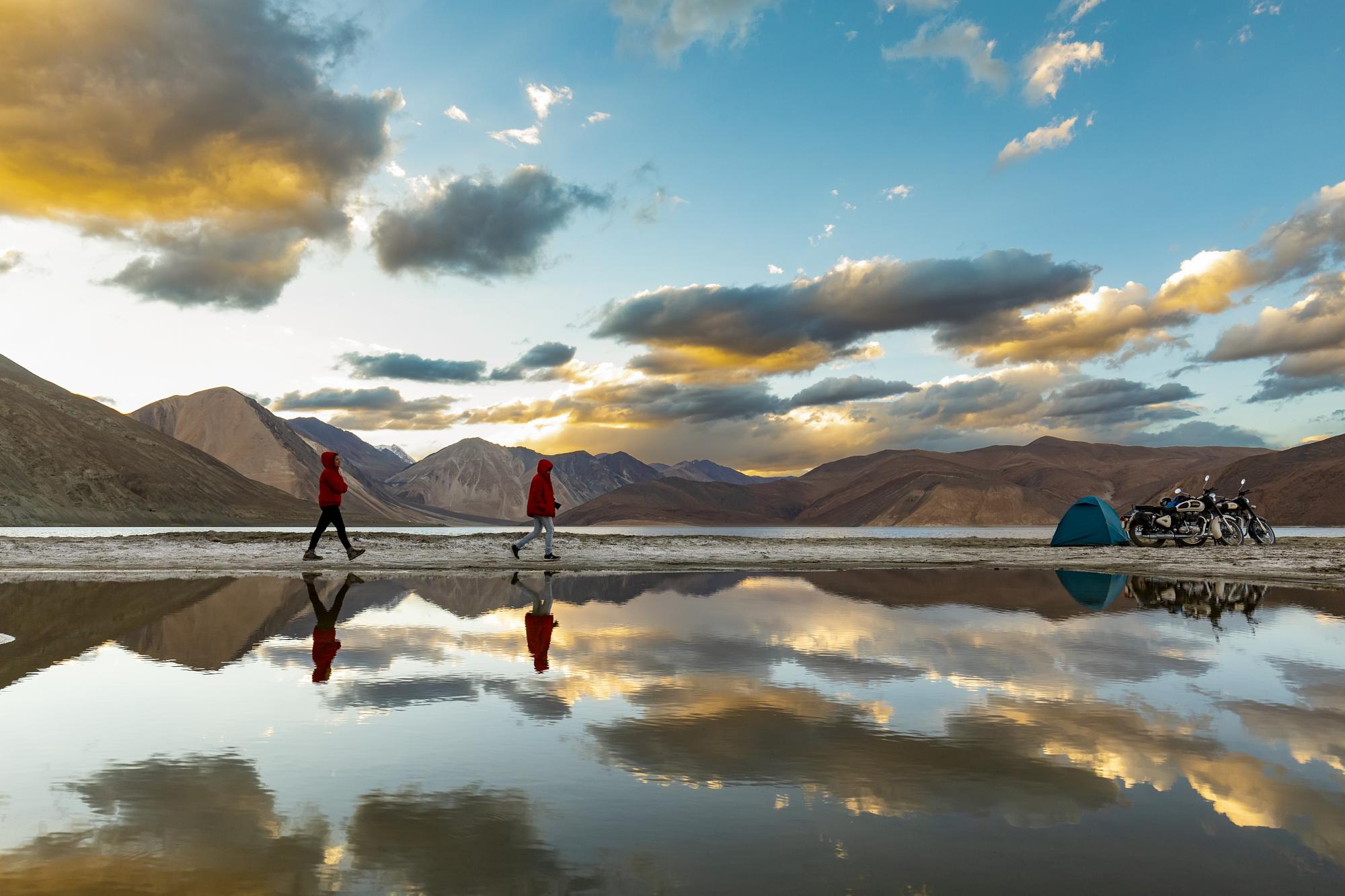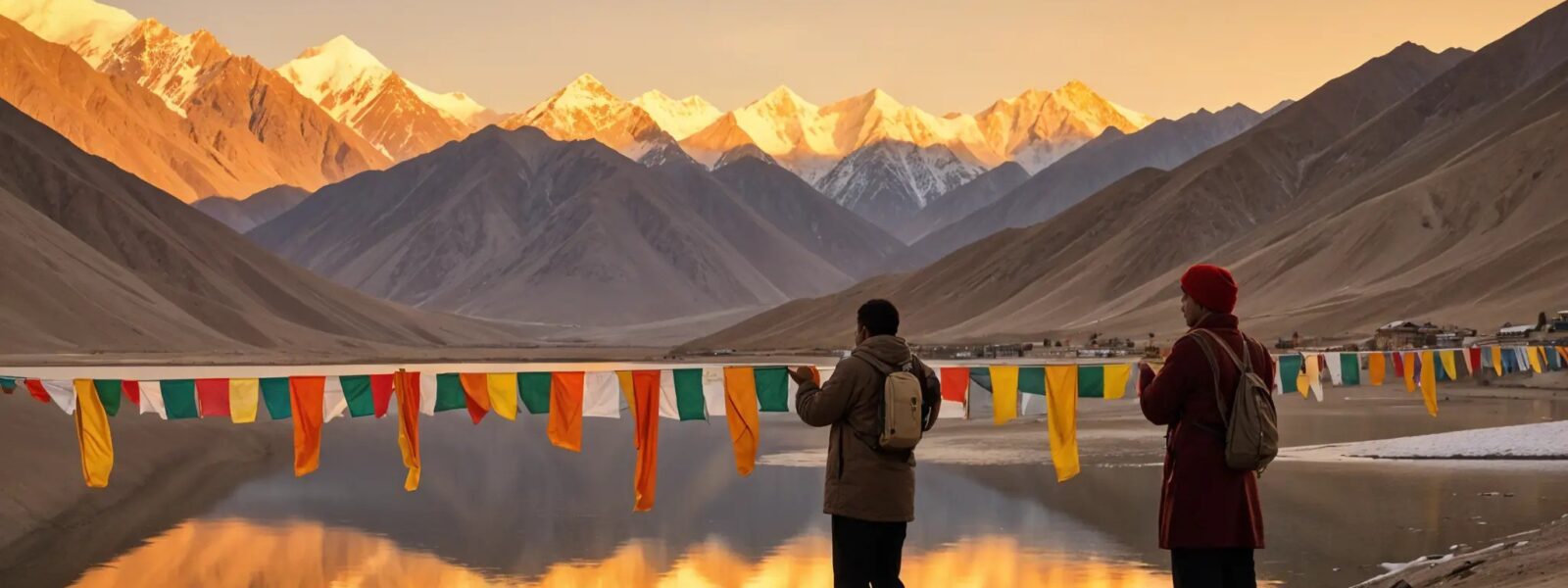Ladakh, often called “The Land of High Passes,” is a destination where dramatic landscapes meet the delicate beauty of dawn. For travelers and photographers alike, witnessing the first rays of sunlight over Ladakh’s peaks and valleys is a life-changing experience. This journey, where sunrise brings both light and life to the Himalayan landscape, has inspired many to return year after year to capture these ephemeral moments. In this guide, we’ll explore the best locations for sunrise in Ladakh, share tips for capturing breathtaking dawn photos, and provide insights for planning a safe and rewarding sunrise adventure.
Introduction to Ladakh’s Breathtaking Sunrises
Ladakh’s rugged terrain, towering mountains, and pristine lakes provide an unparalleled setting for a sunrise experience. As the first rays of dawn appear, they illuminate the stark landscape in soft, golden light, bringing out colors that remain hidden in daylight. Sunrise treks in Ladakh reveal the magnificence of this land in ways few other activities can. From tranquil lakes like Pangong to high passes like Khardung La, Ladakh offers numerous spots for travelers to experience dawn’s quiet magic.
“Witnessing the sunrise over Pangong Lake was unlike anything I’ve ever experienced. The sky and the water turned a shade of gold that felt surreal.”
— Alyssa M., Photographer, United States

Why Ladakh is Ideal for Dawn Exploration
Nestled high in the Himalayas, Ladakh’s unique geography and altitude create prime conditions for dawn experiences. The clear skies, dramatic peaks, and reflective lakes make it an ideal place for sunrise photography. Additionally, the early morning light in Ladakh has a soft quality due to the altitude and crisp air, making colors appear more vibrant. Dawn exploration is particularly rewarding for travelers seeking solitude, as the landscapes remain quiet and untouched by the day’s activities.
Best Peaks and Locations to Watch the First Rays of Sunlight in Ladakh
For a truly unforgettable experience, Ladakh offers several iconic sunrise spots. Here are the top locations where you can capture the first rays of light across Ladakh’s peaks and valleys.
Watching the Sunrise Over Pangong Lake
One of the most famous locations in Ladakh, Pangong Lake is revered for its sunrise views. The lake’s turquoise-blue waters reflect the morning light, creating a stunning spectacle as the sunlight casts a golden glow over the water and surrounding mountains.
“Standing by Pangong Lake at sunrise felt like stepping into another world. It’s so quiet, and the reflections are unbelievable. It’s something you just can’t capture in photos.”
— David L., Travel Writer, United Kingdom
Khardung La Pass: A High-Altitude Sunrise Adventure
For adventurous travelers, Khardung La Pass offers a sunrise experience like no other. Known as one of the highest motorable passes globally, it provides a unique perspective of the sunrise over the Ladakh Valley. As dawn breaks, the sunlight gradually fills the valley below, highlighting Ladakh’s peaks against the Himalayan backdrop.
Sunrise from Tso Moriri Lake
Tso Moriri Lake offers an isolated and serene setting for sunrise. Located in the Changthang region, this high-altitude lake is often quieter than Pangong but equally captivating at dawn. The golden rays illuminate the water, reflecting the majestic snow-covered peaks in the distance, creating a scene that feels like a dream.
Nubra Valley at Dawn
Nubra Valley combines sand dunes with alpine vistas, making it one of Ladakh’s most unique sunrise locations. As dawn arrives, the light brings out rich colors in the sand dunes and casts long shadows across the valley floor. For photographers, Nubra Valley’s varied landscape provides countless opportunities for captivating compositions.

Planning the Perfect Sunrise Trek in Ladakh
The beauty of Ladakh’s sunrises is best experienced up close, making sunrise treks an ideal way to chase the first light. Here’s how to prepare for a safe and rewarding sunrise trek.
Preparing for High-Altitude Sunrises
Since Ladakh’s sunrises often require trekking to high altitudes, it’s crucial to acclimate to avoid altitude sickness. Spend a few days in Leh or another base to adjust to the altitude before attempting sunrise treks. Pack warm layers, as mornings in Ladakh can be extremely cold.
Best Sunrise Trekking Routes in Ladakh
Several routes in Ladakh offer excellent sunrise views. Rizong Monastery and Lamayuru Monastery treks are popular for beginners and seasoned trekkers alike. Both routes provide stunning sunrise views along with the unique experience of watching monks perform their morning rituals, making the trek even more rewarding.

Photography Tips for Capturing Ladakh’s First Light
Sunrise in Ladakh is a photographer’s paradise. Here are some expert tips to help you capture the magic of dawn.
Essential Gear for Sunrise Photography in Ladakh
- Tripod: A tripod is essential for steady shots in low light.
- Wide-angle lens: To capture the expansive landscapes, a wide-angle lens is highly recommended.
- Protective gear for camera: Cold temperatures can impact your camera, so make sure it’s well protected.
Timing and Techniques for Capturing the Golden Hour
The golden hour right after sunrise provides the best light for photography. Try using a lower ISO and slower shutter speed to capture the soft, golden light. Adjusting the exposure manually can help bring out details in the landscape without overexposing the light areas.
The Best Camera Angles and Compositions for Ladakh’s Sunrises
Incorporating natural elements like rocks, water reflections, or distant peaks into your composition helps convey Ladakh’s vastness. Experiment with angles to capture the contrasting elements of light and shadow that give the sunrise depth.
“As a professional photographer, I’ve shot sunrises worldwide, but Ladakh offers some of the most unique compositions I’ve seen. Every angle has its own beauty.”
— Carlos F., Professional Photographer, Spain

Experiencing Ladakh’s Sunrises through Local Culture
Sunrise in Ladakh isn’t just about the scenery. It’s also an opportunity to experience Ladakh’s rich culture.
Sunrise and Spirituality in Ladakh’s Monasteries
Ladakh is home to several monasteries, where monks rise early to chant and pray. Thiksey Monastery is particularly popular for sunrise visits, as the first light creates a spiritual ambiance that aligns with the monks’ rituals. Experiencing dawn at a monastery is a deeply peaceful experience that adds a unique cultural dimension to your sunrise journey.
Dawn at Ladakh’s Traditional Villages
Watching the sunrise over Ladakh’s traditional villages is a humbling experience. As the first light illuminates the village houses, you’ll see locals beginning their day, feeding their animals, or preparing breakfast. This quiet moment connects visitors with Ladakh’s daily life, adding depth to the dawn experience.
“Sunrise in a Ladakhi village is a magical experience. You see a different side of life here — the simplicity and beauty of a day starting in harmony with nature.”
— Sophia R., Cultural Anthropologist, Italy
Seasonal Guide: Best Times of Year to Witness Ladakh’s Sunrises
Timing is everything when it comes to catching Ladakh’s best sunrises. Here’s a quick guide to choosing the best season for your trip.
Why Summer is Ideal for Clear Sunrise Views
Summer in Ladakh, typically from June to September, offers the clearest skies, warmest temperatures, and easiest access to popular sunrise spots like Pangong Lake. This is the best time for trekkers and photographers to capture dawn’s colors without extreme cold.
Experiencing Winter Sunrises in Ladakh
Winter in Ladakh (December to February) brings a unique challenge but rewards visitors with snow-covered landscapes and crystal-clear skies. However, temperatures can be extremely cold, and many areas are accessible only by experienced trekkers or those on guided tours.

Essential Tips for a Safe and Enjoyable Sunrise Trek in Ladakh
Trekking at dawn in Ladakh’s high altitudes requires preparation. Here are some essential tips:
- Dress in layers: Ladakh’s mornings are cold, so layer up to stay warm.
- Start early: For many spots, you’ll need to begin your trek at least 1-2 hours before sunrise.
- Pack essentials: Bring snacks, water, a flashlight, and a map or GPS for navigating in low light.
Frequently Asked Questions about Chasing Sunrises in Ladakh
What are the Best Sunrise Spots in Ladakh?
Pangong Lake, Tso Moriri, Khardung La, and Nubra Valley are top spots for witnessing Ladakh’s incredible sunrises.
What Time Should I Start My Trek to Catch the Sunrise?
Depending on the location, start your trek at least 1-2 hours before sunrise to reach the viewpoint in time.
What Should I Pack for a Sunrise Trek in Ladakh?
Essentials include warm layers, camera gear, snacks, water, and a flashlight or headlamp.
Can Beginners Try Sunrise Treks in Ladakh?
Yes! Many routes, such as those around monasteries and lakes, are beginner-friendly, though acclimatization is necessary.
How Do I Capture the Best Sunrise Photos in Ladakh?
Use a tripod, experiment with angles, and consider using a wide-angle lens to capture the vastness of Ladakh’s landscapes.
Conclusion: Embracing the Magic of Ladakh’s Sunrises
Whether you’re a seasoned traveler, a photography enthusiast, or someone seeking a profound connection with nature, chasing the sunlight across Ladakh’s peaks and valleys is an unforgettable journey. Each sunrise brings a new appreciation for Ladakh’s rugged beauty and quiet tranquility, making it a must for anyone visiting the Himalayas.
Chasing Sunlight in Ladakh
Chasing Sunlight in Ladakh | The journey through Ladakh mirrors the very essence of unraveling unknown horizons, as its dramatic landscapes and unique cultural identity awaken the deepest sense of wonder and exploration. Chasing Sunlight in Ladakh delves into this realm where inner peace intertwines with the wild, untouched beauty of Ladakh. From the snow-capped peaks to the serene monasteries, every step in Ladakh is a step toward self-discovery. The mountains, ancient paths, and unspoken mysteries stretch before travelers, offering a meditative experience where each encounter feels both effortless and transformative. Whether it’s trekking across remote valleys or sitting quietly beside a sacred lake, Ladakh invites those who seek a deeper connection to the natural and spiritual world.

Chasing Sunlight in Ladakh
The monasteries of Ladakh stand as living monuments to the region’s profound spiritual heritage. With origins dating back over a thousand years, these ancient structures are both places of worship and repositories of art, culture, and wisdom. Hemis Monastery, one of the largest in Ladakh, is renowned for its annual festival, featuring colorful mask dances performed by monks. The history of these monasteries reflects Ladakh’s role as a crossroads between India, Tibet, and Central Asia, where religious and cultural influences have intertwined over the centuries.
The Tibetan Buddhist influence is especially evident in the architecture and daily life of the monks. Prayer wheels, intricate murals, and the soft hum of chants fill the air as visitors explore the monastery grounds. Each monastery, from the remote Lamayuru to the awe-inspiring Thiksey, offers a window into the spiritual heart of Ladakh. These centers of meditation, learning, and community life continue to thrive, preserving traditions that have shaped Ladakh for generations.
Why Visit Ladakh for Chasing Sunlight in Ladakh?
Ladakh is a destination that transcends mere travel. It offers a journey that touches both the outer and inner landscapes, making it a perfect setting for those who seek to unravel their own unknown horizons. The region’s breathtaking scenery—from towering mountain ranges to hidden valleys—provides not just an escape but a space for contemplation and growth. Ladakh’s culture, deeply rooted in Buddhist practices, invites visitors to reflect on their own lives and the world around them.
Ladakh’s people, known for their warmth and hospitality, add to the richness of the experience. Villages like Sumda Chun and the legendary Nubra Valley introduce travelers to a way of life that is intricately connected to nature and spirituality. Staying in local homestays allows for immersive experiences where one can learn about traditional Ladakhi customs, share meals made from local produce, and participate in community rituals.

Beyond its natural beauty, Ladakh offers a unique opportunity to explore oneself. The vastness of the region’s plateaus and the clarity of its skies seem to mirror the vastness of the human spirit. Whether it’s standing atop a mountain pass at 18,000 feet or meditating in a centuries-old monastery, Ladakh helps unravel the unknown horizons within each traveler.
Finding the Best Chasing Sunlight in Ladakh in Ladakh
Finding the best places in Ladakh to experience “Chasing Sunlight in Ladakh” involves venturing off the beaten path. Ladakh’s lesser-known treks, such as those leading to secluded monasteries or high-altitude lakes, offer unparalleled opportunities for solitude and reflection. The Markha Valley trek, for instance, takes travelers through verdant valleys, ancient villages, and high-altitude passes, allowing for both physical and spiritual exploration.
Ladakh’s iconic lakes, including Pangong Tso and Tso Moriri, are ideal spots for quiet contemplation. Their still waters reflect the sky, creating a mesmerizing landscape that feels timeless and infinite. Sitting beside these lakes, especially at dawn or dusk, brings an overwhelming sense of peace and connection with nature.

For those interested in Ladakh’s spiritual heritage, exploring monasteries such as Alchi, Phyang, or Diskit can be a transformative experience. These sites are not just places of worship but also centers of art, philosophy, and wisdom. Visiting these monasteries, with their ancient murals and intricate statues, offers insight into Ladakh’s rich cultural tapestry.
Ladakh’s Atmosphere and Chasing Sunlight in Ladakh
Ladakh’s atmosphere is unlike any other place on Earth. The stark contrasts between the rugged mountains and the serene, tranquil monasteries create an environment that feels both raw and sacred. The traditional decor in Ladakhi homes and religious sites reflects this balance, with mud-brick houses adorned with prayer flags and colorful thangkas (Buddhist paintings) that add warmth and spiritual meaning to the space.

The interiors of Ladakhi homes, often simple and functional, are filled with symbols of devotion. Small shrines dedicated to Buddhist deities are common, and the air is often fragrant with incense. The use of earthy materials, like stone and wood, along with brightly colored textiles, creates an inviting and peaceful space, perfect for relaxation and reflection.
Traditional Ladakhi Cuisine
Traditional Ladakhi cuisine is an integral part of the region’s identity, offering a unique blend of flavors that reflect its harsh climate and remote location. Hearty, warming dishes such as thukpa (noodle soup) and momos (dumplings) provide the sustenance needed to endure Ladakh’s cold temperatures. Skyu, a thick stew made with root vegetables and barley, is another staple of the Ladakhi diet, designed to nourish both body and spirit.

Drinks like butter tea, made with yak butter and salt, are a must-try for anyone visiting Ladakh. This rich, savory drink is not only warming but also hydrating, making it essential for those venturing into the high-altitude regions of Ladakh. Chang, a local barley beer, is often enjoyed during festivals and community gatherings, adding a sense of joy and camaraderie to any occasion.
Live Cultural Chasing Sunlight in Ladakh in Ladakh
Ladakh is home to a vibrant cultural scene, with festivals and live performances held throughout the year. The Hemis Festival, which celebrates the birth of Guru Padmasambhava, is one of the largest and most famous events in the region. Monks dressed in elaborate costumes perform cham dances, which depict the triumph of good over evil. The energy of the festival, with its bright colors, rhythmic music, and elaborate rituals, draws visitors from around the world.
Other local festivals, such as the Losar (New Year) and Ladakh Festival, provide visitors with the chance to witness traditional dance, music, and crafts that have been passed down through generations. These events are more than just entertainment; they are a celebration of Ladakh’s rich cultural heritage and its deep connection to the spiritual world.
Trekking and Outdoor Activities Chasing Sunlight in Ladakh
Ladakh is a trekker’s paradise, offering some of the most stunning and challenging routes in the world. From the famous Chasing Sunlight in Ladakh, which follows the frozen Zanskar River, to lesser-known routes like the Sham Valley or Nubra Valley treks, Ladakh’s landscape offers endless possibilities for adventure and discovery. The high-altitude passes, such as Khardung La and Chang La, offer breathtaking views of snow-capped peaks and sprawling valleys.

Wildlife enthusiasts will also find Chasing Sunlight in Ladakh to be a haven for rare species such as the snow leopard, Himalayan blue sheep, and the Tibetan wild ass. Winter expeditions to spot the elusive snow leopard in the Hemis National Park are gaining popularity among wildlife photographers and conservationists alike.
The Importance of Preserving Ladakh’s Chasing Sunlight in Ladakh
Ladakh’s rich cultural and environmental Chasing Sunlight in Ladakh is under increasing threat from climate change and mass tourism. Preserving this unique region requires careful attention to sustainable tourism practices. Choosing eco-friendly accommodations, supporting local businesses, and participating in community-led conservation efforts are just a few ways that visitors can contribute to the preservation of Ladakh’s natural and cultural heritage.
Ladakh’s people have a long history of living in harmony with their environment, practicing sustainable agriculture, and maintaining a deep spiritual connection to the land. Visitors are encouraged to follow the same principles, leaving no trace and respecting the fragile ecosystems that make Ladakh so special.
Etiquette and Tips for Visiting Chasing Sunlight in Ladakh
Before visiting Ladakh, it’s essential to understand and respect the region’s customs and traditions. As a deeply spiritual place, Ladakh requires visitors to dress modestly, especially when visiting monasteries or attending religious ceremonies. Always ask for permission before taking photographs inside monasteries or of local people.
Medical Chasing Sunlight in Ladakh
Spa trail Chasing Sunlight in Ladakh
Chasing Sunlight in Ladakh

When Chasing Sunlight in Ladakh, remember to stay on designated paths to avoid damaging fragile ecosystems. Tipping is appreciated but not expected in most settings, and it’s important to carry cash, as many remote areas do not accept credit cards. Lastly, be mindful of altitude sickness and take the necessary precautions when traveling to higher elevations.
Conclusion: Enjoying Chasing Sunlight in Ladakh in Ladakh
Ladakh is a place where the physical and spiritual worlds converge, offering travelers a journey unlike any other. Whether you’re trekking across high-altitude deserts, exploring ancient monasteries, or simply sitting in quiet reflection by a mountain lake, Ladakh invites you to unravel your own unknown horizons. By respecting the region’s traditions and practicing sustainable tourism, you help ensure that Ladakh’s beauty and cultural richness will be preserved for future generations to explore and enjoy.

